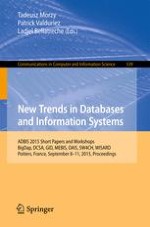This book constitutes the thoroughly refereed short papers and workshop papers of the 19th East European Conference on Advances in Databases and Information Systems, ADBIS 2015, held in Poitiers, France, in September 2015. The 31 revised full papers and 18 short papers presented were carefully selected and reviewed from 135 submissions. The papers are organized in topical sections on ADBIS Short Papers; Second International Workshop on Big Data Applications and Principles, BigDap 2015; First International Workshop on Data Centered Smart Applications, DCSA 2015; Fourth International Workshop on GPUs in Databases, GID 2015; First International Workshop on Managing Evolving Business Intelligence Systems, MEBIS 2015; Fourth International Workshop on Ontologies Meet Advanced Information Systems, OAIS 2015; First International Workshop on Semantic Web for Cultural Heritage, SW4CH 2015; First International Workshop on Information Systems for AlaRm Diffusion, WISARD 2015.
